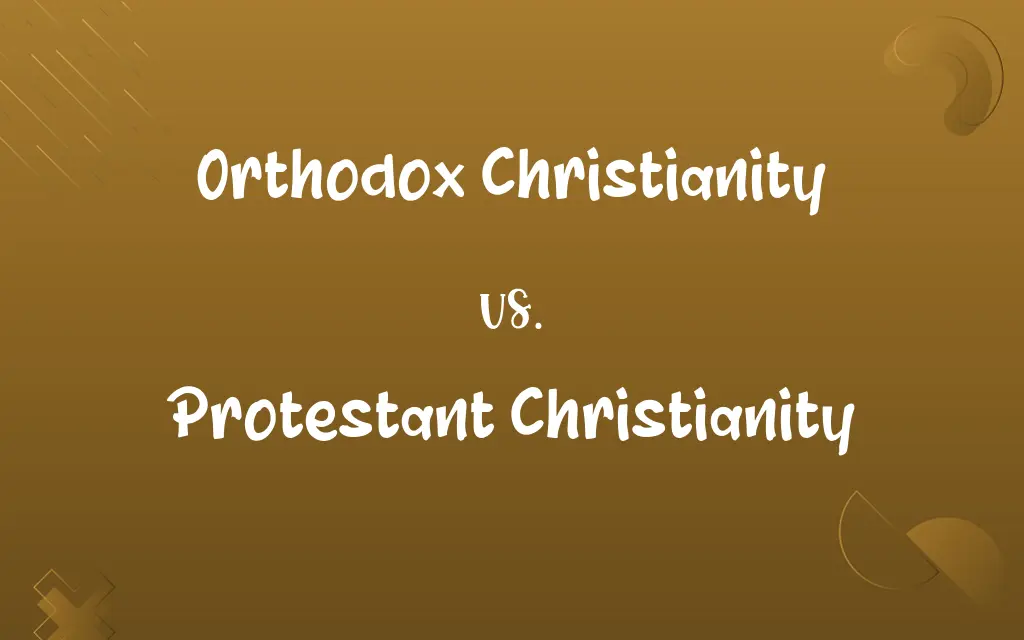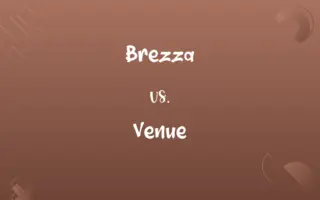Orthodox Christianity vs. Protestant Christianity: Know the Difference

By Shumaila Saeed || Published on February 16, 2024
Orthodox Christianity focuses on tradition and liturgy, adhering to early teachings and practices, while Protestant Christianity arose from the Reformation, emphasizing scripture and faith over tradition.

Key Differences
Orthodox Christianity, established on the traditions and practices of the early church, places significant emphasis on continuity and preserving the original teachings. Protestant Christianity, originating from the 16th-century Reformation, focuses on the authority of the Scripture over traditional practices, advocating for direct personal relationships with God without the need for intercession by church hierarchy.
Shumaila Saeed
Feb 16, 2024
The worship style in Orthodox Christianity is liturgical and highly ceremonial, characterized by ancient rituals and symbolic gestures deeply rooted in early Christian traditions. In contrast, Protestant Christianity often adopts a more simplified form of worship, with less emphasis on rituals and more on preaching and communal singing, reflecting its principle of accessible worship for all believers.
Shumaila Saeed
Feb 16, 2024
Orthodox Christianity maintains a hierarchical structure of clergy, including bishops, priests, and deacons, who play a central role in the administration of sacraments and rituals. Protestant Christianity, while also having clergy, often emphasizes the priesthood of all believers, reducing the hierarchical structure and giving individual congregations more autonomy.
Shumaila Saeed
Feb 16, 2024
In terms of doctrine, Orthodox Christianity adheres to the decisions of the first seven ecumenical councils and emphasizes the mystery of faith, with a strong focus on theosis or deification. Protestant Christianity is characterized by a wide variety of denominational beliefs but generally centers on the justification by faith, individual conscience, and the authority of the Bible.
Shumaila Saeed
Feb 16, 2024
Orthodox Christianity uses icons and other religious imagery extensively in worship and devotional practices, viewing them as windows to the divine. Protestant Christianity, especially in its early years, often rejected religious images in churches, advocating for a more direct and unmediated approach to God.
Shumaila Saeed
Feb 16, 2024
ADVERTISEMENT
Comparison Chart
Origin
Early Christian traditions and practices.
16th-century Reformation against Catholic Church practices.
Shumaila Saeed
Feb 16, 2024
Authority
Tradition, Church Fathers, and Ecumenical Councils.
Scripture and individual faith.
Shumaila Saeed
Feb 16, 2024
Worship Style
Liturgical, ceremonial, with extensive use of icons.
Simpler, with emphasis on preaching and communal singing.
Shumaila Saeed
Feb 16, 2024
Clergy and Hierarchy
Strong hierarchical structure with bishops, priests, and deacons.
Less hierarchy, often emphasizes the priesthood of all believers.
Shumaila Saeed
Feb 16, 2024
Key Doctrines
Theosis, adherence to early ecumenical councils.
Justification by faith, authority of the Bible.
Shumaila Saeed
Feb 16, 2024
ADVERTISEMENT
Approach to Tradition
Maintains ancient traditions and rituals.
Often questions and reforms traditional practices.
Shumaila Saeed
Feb 16, 2024
Use of Religious Imagery
Extensive use of icons and religious art.
Varied, some denominations limit or reject religious imagery.
Shumaila Saeed
Feb 16, 2024
Orthodox Christianity and Protestant Christianity Definitions
Orthodox Christianity
It adheres to the decisions of the first seven ecumenical councils.
Orthodox Christianity bases its doctrines on the outcomes of the early ecumenical councils.
Shumaila Saeed
Jan 18, 2024
Protestant Christianity
It emphasizes the authority of the Bible and the concept of justification by faith.
The cornerstone of Protestant Christianity is the belief in salvation through faith alone.
Shumaila Saeed
Jan 18, 2024
Orthodox Christianity
Orthodox Christianity places a strong emphasis on icons and religious art in worship.
In Orthodox Christianity, icons are venerated as sacred.
Shumaila Saeed
Jan 18, 2024
ADVERTISEMENT
Protestant Christianity
Protestant Christianity is a branch of Christianity that originated from the Reformation.
Protestant Christianity began as a movement to reform the Catholic Church.
Shumaila Saeed
Jan 18, 2024
Orthodox Christianity
Orthodox Christianity is a Christian tradition emphasizing apostolic continuity and ancient liturgical practices.
The Orthodox Christianity service was filled with rich, ancient rituals.
Shumaila Saeed
Jan 18, 2024
Protestant Christianity
It advocates for the priesthood of all believers, reducing clerical hierarchy.
Protestant Christianity empowers individual believers in their spiritual journey.
Shumaila Saeed
Jan 18, 2024
Orthodox Christianity
It is one of the oldest Christian traditions, maintaining early Christian teachings.
Orthodox Christianity closely follows the practices of the early church.
Shumaila Saeed
Jan 18, 2024
Protestant Christianity
Protestant Christianity often features a simplified worship style focused on preaching.
In Protestant Christianity, sermons are a central part of worship.
Shumaila Saeed
Jan 18, 2024
Orthodox Christianity
Orthodox Christianity is known for its structured liturgy and hierarchical clergy system.
The hierarchical clergy system is a distinctive feature of Orthodox Christianity.
Shumaila Saeed
Jan 18, 2024
Protestant Christianity
Protestant Christianity includes various denominations with diverse practices and beliefs.
The diversity of denominations is a characteristic of Protestant Christianity.
Shumaila Saeed
Jan 18, 2024
Repeatedly Asked Queries
What is the main focus of Orthodox Christianity?
Orthodox Christianity focuses on tradition, liturgy, and maintaining the teachings of the early church.
Shumaila Saeed
Feb 16, 2024
What sparked the start of Protestant Christianity?
Protestant Christianity began as a reform movement against certain practices of the Catholic Church in the 16th century.
Shumaila Saeed
Feb 16, 2024
Do Orthodox Christians use icons in worship?
Yes, icons are an integral part of worship in Orthodox Christianity.
Shumaila Saeed
Feb 16, 2024
How does the clergy system differ between the two?
Orthodox Christianity has a structured hierarchy, while Protestant Christianity often emphasizes the priesthood of all believers.
Shumaila Saeed
Feb 16, 2024
What is a key belief in Protestant Christianity?
A key belief is justification by faith and the authority of Scripture.
Shumaila Saeed
Feb 16, 2024
Can women be priests in Orthodox Christianity?
No, Orthodox Christianity does not ordain women as priests.
Shumaila Saeed
Feb 16, 2024
What is theosis in Orthodox Christianity?
Theosis is the process of becoming more like God, a central doctrine in Orthodox Christianity.
Shumaila Saeed
Feb 16, 2024
Are all Protestant Christians the same in beliefs and practices?
No, Protestant Christianity includes a wide variety of denominations with diverse beliefs and practices.
Shumaila Saeed
Feb 16, 2024
Is congregational singing common in Protestant Christianity?
Yes, congregational singing and hymns are a key part of worship in many Protestant denominations.
Shumaila Saeed
Feb 16, 2024
How is the Holy Communion viewed differently?
Orthodox Christianity has a mystical view of Communion, while Protestant interpretations vary, often seeing it as symbolic.
Shumaila Saeed
Feb 16, 2024
Do both branches recognize saints?
Yes, but their understanding and veneration of saints differ significantly.
Shumaila Saeed
Feb 16, 2024
Are Protestant services liturgical?
Some are, but many Protestant denominations favor a less formal structure.
Shumaila Saeed
Feb 16, 2024
Do Protestant Christians use religious imagery?
This varies by denomination, but many Protestant churches are more restrained in their use of religious imagery compared to Orthodox Christianity.
Shumaila Saeed
Feb 16, 2024
Do Orthodox Christians celebrate the same holidays as Protestant Christians?
Generally, yes, but there can be differences in dates and traditions due to different liturgical calendars.
Shumaila Saeed
Feb 16, 2024
Do Protestant churches have bishops?
Some Protestant denominations have bishops, but others do not.
Shumaila Saeed
Feb 16, 2024
What languages are used in Orthodox Christian services?
Orthodox services are often conducted in ancient or traditional languages like Greek, Slavic languages, or the local vernacular.
Shumaila Saeed
Feb 16, 2024
How is the church governed in Orthodox Christianity?
It's governed by a hierarchy of bishops and synods, with no single central authority like the Pope.
Shumaila Saeed
Feb 16, 2024
What role do ecumenical councils play in Orthodox Christianity?
Orthodox Christianity adheres to the decisions of the first seven ecumenical councils for doctrine and practice.
Shumaila Saeed
Feb 16, 2024
How do Orthodox Christians view the Bible?
Orthodox Christians revere the Bible as sacred but also place strong emphasis on tradition and church teachings.
Shumaila Saeed
Feb 16, 2024
How do Orthodox and Protestant Christians view salvation?
Orthodox Christianity emphasizes a mystical path to salvation, while Protestant Christianity focuses on faith and grace.
Shumaila Saeed
Feb 16, 2024
Share this page
Link for your blog / website
HTML
Link to share via messenger
About Author
Written by
Shumaila SaeedShumaila Saeed, an expert content creator with 6 years of experience, specializes in distilling complex topics into easily digestible comparisons, shining a light on the nuances that both inform and educate readers with clarity and accuracy.









































































